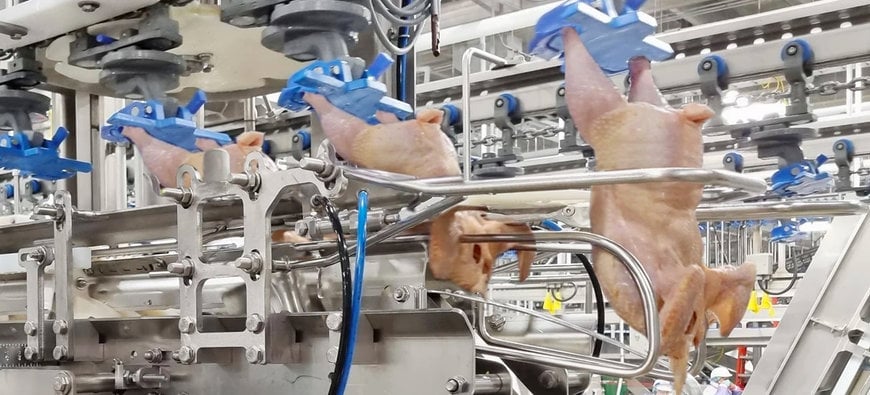www.industry-asia-pacific.com
12
'23
Written on Modified on
MAREL INTRODUCES CUT-UP TECHNOLOGY FOR ASIAN TASTES
The Asian market for chicken parts has some very specific requirements. The new ACM-NT modules from Marel meet all requirements to serve specific markets.

These result from traditional manual cuts usually done by skilled labour. Manual cut-up is, however, no longer an option given today’s production volumes and the shortage of people. In its new ACM-NT modules, the Neck Cutter HY and the Second Joint Wing Cutter HPP, Marel has really succeeded in mimicking the hand/knife movements demanded by these cuts.
Second Joint Wing Cutter HPP cuts consistently
In Chinese and Asian markets, the second wing joint (also known as wing flat, center wing or wingette) is a top-quality end product with a much higher value than breast meat. For a perfect second joint wing cut, it is crucial to keep closed the tip of the skin between the first and second joints. This gives the right product appearance and the highest yield. The fully anatomic cut should respect Chinese tradition, with superb skin coverage, intact epidermis and no cartilage damage.
Meeting the requirements
As the second joint is a very complex structure with irregularly shaped bones, a simple straight cut will not give the required result. Automated cutting should involve a series of precise and consistent movements. To ensure that the right amount of skin is harvested along with the second joint, the new Second Joint Wing Cutter HPP features a dedicated pre-incision blade. It can equal a skilled manual cut to give an excellent presentation and a very high yield.
‘Catching’ the bone joint
Each wing entering the module is immediately ‘caught’ by its own dedicated ‘active transporting unit’ that moves the wing towards the blade holder. The wing joint is pushed into its optimal position and the module ‘feels’ automatically where the bone joint is located. The Second Joint Wing Cutter HPP is not sensitive to variations in weight or shape. The static knife makes a consistent anatomic cut precisely at the right position of the joint.
Neck Cutter HY cuts long necks cleanly
In Chinese and Asian markets the chicken neck is a high-value product. It is eaten in many different ways, on a skewer, as a snack, as street food, or as part of a dish. When cutting up a chicken carcass, attention should be paid to the careful harvesting of the whole neck. It should be as long as possible, but without damage to valuable pieces of the breast skin and meat, and without breast contamination from crop skin or crop fat.
Harvesting
In the evisceration process, chicken necks are cracked, trachea and esophagus having already been removed. In the cut-up department, the process is completed by harvesting the neck as a consumer product. The Marel Neck Cutter HY achieves optimal neck yield and enhances breast skin quality. It can even benefit wing-cutting quality. And what is more, it does all this while saving labour. There’s no longer any need for an additional worker to remove manually any residual crop skin or crop fat in the downstream breast deboning line.
Effective cutting
Product guides position the necks before they enter the cutting unit and bend away the wings to prevent them from being cut. Thanks to an ingenuous pulling transport mechanism, the Neck Cutter HY cuts the neck extremely effectively, carefully and tidily at exactly the right location to make it as long as possible. The module uses a non-aggressive, spring-loaded chain that adapts to every weight and size. Rotating blades then sever the neck from the product.
Neck length and breast skin
All the above Marel technologies give an additional 30mm [1.2“] neck length. However, length is not everything. The neck cutter has to find a compromise between a long neck cut - up to the scapula bone - and breast skin quality. The Marel Neck Cutter HY gives processors the opportunity of adjusting settings to their individual preferences.
www.marel.com

